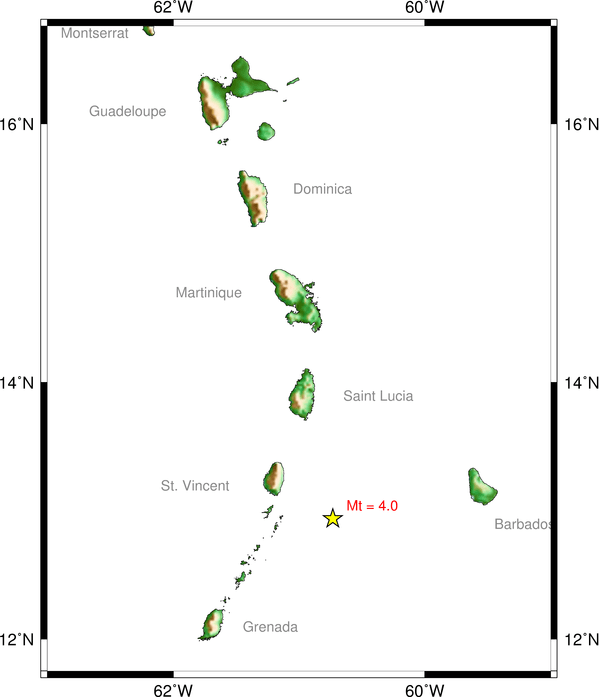KINGSTOWN – An earthquake to the southeast of St. Vincent Thursday night was said to have been felt here and in St. Lucia.
The Seismic Research Centre of the University of the West Indies said the earthquake was magnitude 4.0.
It occurred at 10:50 p.m. local time and was located at 12.94° north and 60.73° west at a depth of 29 kilometres.
The research centre said the results are preliminary and may vary slightly when additional data is processed.

The Seismic Research Centre provides the following earthquake safety information:
Before an earthquake
• Build your home in accordance with the recommended building codes. See your local disaster management office for details.
• Bolt heavy furniture, water tanks, water heaters, gas cylinders and storage units to a wall or floor.
• Place largest and heaviest items on lower shelves.
• Emergency items such as canned foods, medication, flashlights, battery-operated radios, fire extinguishers and a First Aid kit should be readily available and working properly.
• All family members should know how to use this emergency equipment and should know how to turn off electricity, gas and water using safety valves and main switches.
• All family members should know what to do during an earthquake and should practice these safety tips through regular drills.
During an earthquake
• STAY CALM. DO NOT PANIC. BE ALERT.
• If inside stay inside, do not run out of the building.
• If inside, stand in a strong doorway or get under a sturdy desk, table or bed and hold on. Do not use elevators or stairs. Move away from windows, mirrors, glass doors, pictures, bookcases, hanging plants and heavy objects.
• If outside and there are no obvious signs of danger nearby, stay there.
• If outside, stay away from glass buildings, electricity poles, and bridges.
• If in a vehicle, do not stop on or under a bridge.
• Always look out for falling plaster, bricks, lighting fixtures and other objects.
If trapped under debris
• Do not light a match.
• Do not move about or kick up dust.
• Cover your mouth with a handkerchief or clothing.
• Tap on a pipe or wall so rescuers can locate you. Use a whistle if one is available. Shout only as a last resort. Shouting can cause you to inhale dangerous amounts of dust.
After an earthquake
DO
• Check for broken gas lines and fires.
• Check utilities and switch them off, if necessary.
• Check your house for serious damage and evacuate if the house seems likely to collapse.
• Be prepared for more earthquakes (aftershocks).
• Stay away from landslide-prone areas.
• Turn on transistor radio for emergency news.
• If possible, check the Seismic Research Centre’s website at www.uwiseismic.com for updates on the earthquake.
DO NOT
• Do not light a match or turn on a light switch. Use a flashlight instead.
• Never touch fallen power lines.
• Do not go sightseeing. Leave the streets clear for emergency and rescue vehicles.
• Do not attempt to move seriously injured persons unless they are in danger of further injury.
What about the Triangle of Life?
This is a widely circulated suggestion which states that during an earthquake it is safer to curl up next to a desk or bed rather than to go under it. We do not recommend this practice for the following reasons:
• The Triangle of Life is not a scientifically proven theory.
• It is unknown if during the earthquake these “triangles of life” – spaces next to desks, beds etc.- are impacted in any way which may make them unsafe areas.
• In the Eastern Caribbean, ‘pancaking’ or crumbling of buildings which would crush occupants as described in the ‘Triangle of Life’, is not expected.
Scientists recommend that the safety measures outlined in this website be used to protect yourself from the effects of earthquakes in the Eastern Caribbean.





